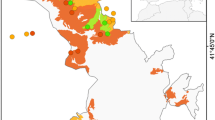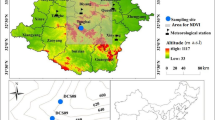Abstract
Based on the data of stand investigation and stem analysis, the effects of climate factors on the poplar protection forest increment in the riverbank field of the Dalinghe and Xiaolinghe rivers of Liaoning Province, China were studied by stepwise regression procedure and grey system theories and methods. A regression model reflecting the correlation between the height increment of poplar protection forest and climatic factor was developed. The order of grey relevance for the effect of climatic factors on the height increment of poplar protection forest is: light>water>heat, and it could be interpreted that the poplar increment was mainly influenced by light factor, water factor, and heat factor. This result will provide scientific basis for the intensive cultivation and regenration of the poplar protection forest in riverbank field in similar regions in China.
Similar content being viewed by others
References
Chen Guoliang 1986. Application of computer in agricultural system model [M]. Xian: Shanxi Science, and Technique Press, p133–150. (in Chinese)
Chen Panqin, Guo Yufu. 1993. Advances of global climate change research [J]. Jounral of Environmental Sciences,14(4): 16–23. (in Chinese)
Drake, B.G., Muehe, M.S., Peresta, G.,et al. 1996. Acclimation of photosynthesis respiration and ecosystem carbon flux of wetland on Chesapeake Bay. Maryland to elevated atmospheric CO2 concentration [J]. Plant and Soil,187: 111–118.
Fan Zhiping., Zeng Dehui,et al. 2002. Advance in Characteristics of ecological effect of farmaland shelterbelts [J]. Journal of Soil and Water Conservation,16(4): 124–130.
Fang Jingyun. 2000. Global ecology-climate change and ecological response [M]. Beijing: Higher Education Press. (in Chinese)
Han Shijie, Zhou Yumei, Wang Chenruiet al. 2001. Eco-physiological response ofPinus koraiensis seedlings to elevated CO2 [J]. Chinese Journal of Applied Ecology,12(1): 27–30. (in Chinese)
He, H.S., Mladenoff, D.J., Crow, T.R., 1999. Linking an ecosystem model and a landscape model to study forest species response to climate warming [J]. Ecol. Model.,112: 213–233.
Jiang Youxu. 1992. Global climate change and prediction in forest of China [J]. Sci Silvae Sin,28(5): 431–438. (in Chinese)
Leverenz, J.W., Bruhn, D., Saxe, H. 1999. Responses of two provenances ofFagus sylvatica seedlings to a combination of four temperature and two CO2 treatments during their first growing season: gas exchange of leaves and roots [J]. New Phytologist.144: 437–454.
Lewis, J.D., Olszyk, D., Tingey, D.T. 1999. Seasonal Patterns of Photosynthetic light response in Douglas-fir seedlings subjected to elevated atmospheric CO2 and temperature [J]. Tree Physiology,19: 243–252.
Liu Guohua, Fu Bojie. 2001. Effects of global climate change on the forest ecological systems[J]. Journal of Natural Resources,16(1): 71–78. (in Chenese)
Richie, J.C. 1986. Clilmate change and vegetation response [J]. Vegetation,67: 65–74.
Walker, B., Steffen, W. 1997. An overview of the implication of global change for natural and managed terrestrial ecosystem [J]. Conservation Ecology,1(2): 2–20.
Xun Shuohua, Cao Hanyu, Wu Dejun. 1995. Correlation analysis between the increment and site factors of Japan larch [J]. Journal of Shandong Normal University,10(3): 264–266. (in Chinese)
Yan Zhiyuan. 1989. Grey system practical program [M]. Nanjing: Jiangsu Science and Technique Press. (in Chinese)
Zhang Xinshi, Zhou Guangsheng, Gao Qionget al., 1997. Study of global change and terrestrial ecosystems in China [J]. Earth Science Frontiers,4(2): 137–144. (in Chinese)
Zhou Lahu. 2002. Differential analysis of the influence of climate factors influence on poplar shelter-belt increment in Hexi corridor [J]. Journal of Gansu Agricultural University,3: 447–450 (in Chinese)
Author information
Authors and Affiliations
Additional information
Foundation item: This study was supported by the National Natural Science Foundation of China (No. 30270250), and a key direction project (No. C12MC-SCMS013)
Biography: LI Hai-mei (1975-), female, Ph. D, department of Landscpe Architecture. Art. Laiyang Agricultural College, Shandong Qingdao 266109, P. R. China.
Responsible editor: Song Funan
Rights and permissions
About this article
Cite this article
Li, Hm., He, Xy. & Wang, Kl. Effects of climate factors on the height increment of poplar protection forest in the riverbank field. J. of For. Res. 15, 177–180 (2004). https://doi.org/10.1007/BF02911020
Received:
Issue Date:
DOI: https://doi.org/10.1007/BF02911020




